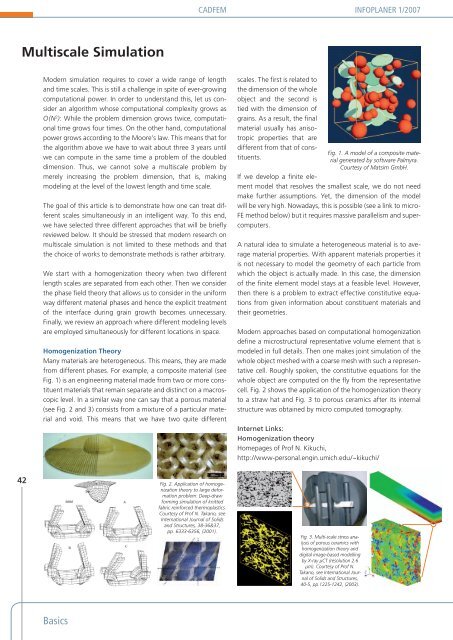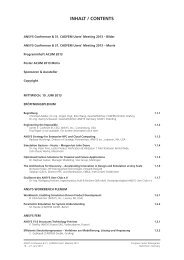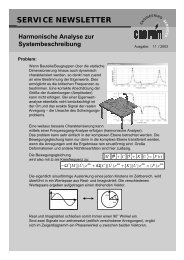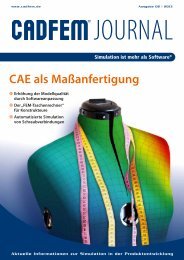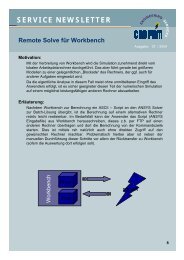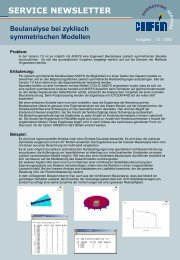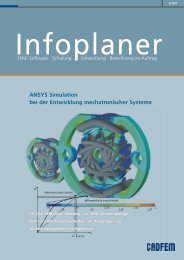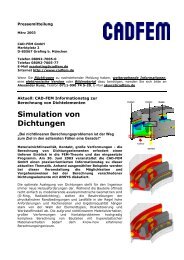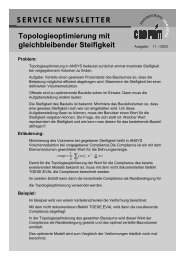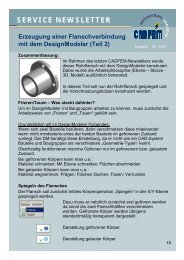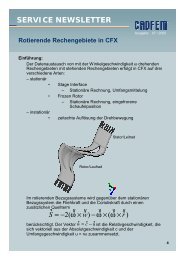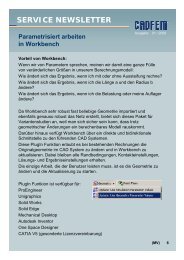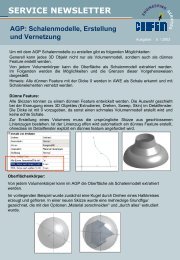Infoplaner 1-2007 - Cadfem
Infoplaner 1-2007 - Cadfem
Infoplaner 1-2007 - Cadfem
Sie wollen auch ein ePaper? Erhöhen Sie die Reichweite Ihrer Titel.
YUMPU macht aus Druck-PDFs automatisch weboptimierte ePaper, die Google liebt.
CADFEM INFOPLANER 1/<strong>2007</strong>Multiscale SimulationModern simulation requires to cover a wide range of lengthand time scales. This is still a challenge in spite of ever-growingcomputational power. In order to understand this, let us consideran algorithm whose computational complexity grows asO(N 2 ): While the problem dimension grows twice, computationaltime grows four times. On the other hand, computationalpower grows according to the Moore’s law. This means that forthe algorithm above we have to wait about three 3 years untilwe can compute in the same time a problem of the doubleddimension. Thus, we cannot solve a multiscale problem bymerely increasing the problem dimension, that is, makingmodeling at the level of the lowest length and time scale.The goal of this article is to demonstrate how one can treat differentscales simultaneously in an intelligent way. To this end,we have selected three different approaches that will be brieflyreviewed below. It should be stressed that modern research onmultiscale simulation is not limited to these methods and thatthe choice of works to demonstrate methods is rather arbitrary.We start with a homogenization theory when two differentlength scales are separated from each other. Then we considerthe phase field theory that allows us to consider in the uniformway different material phases and hence the explicit treatmentof the interface during grain growth becomes unnecessary.Finally, we review an approach where different modeling levelsare employed simultaneously for different locations in space.Homogenization TheoryMany materials are heterogeneous. This means, they are madefrom different phases. For example, a composite material (seeFig. 1) is an engineering material made from two or more constituentmaterials that remain separate and distinct on a macroscopiclevel. In a similar way one can say that a porous material(see Fig. 2 and 3) consists from a mixture of a particular materialand void. This means that we have two quite differentscales. The first is related tothe dimension of the wholeobject and the second istied with the dimension ofgrains. As a result, the finalmaterial usually has anisotropicproperties that aredifferent from that of constituents.Fig. 1. A model of a composite materialgenerated by software Palmyra.Courtesy of Matsim GmbH.If we develop a finite elementmodel that resolves the smallest scale, we do not needmake further assumptions. Yet, the dimension of the modelwill be very high. Nowadays, this is possible (see a link to micro-FE method below) but it requires massive parallelism and supercomputers.A natural idea to simulate a heterogeneous material is to averagematerial properties. With apparent materials properties itis not necessary to model the geometry of each particle fromwhich the object is actually made. In this case, the dimensionof the finite element model stays at a feasible level. However,then there is a problem to extract effective constitutive equationsfrom given information about constituent materials andtheir geometries.Modern approaches based on computational homogenizationdefine a microstructural representative volume element that ismodeled in full details. Then one makes joint simulation of thewhole object meshed with a coarse mesh with such a representativecell. Roughly spoken, the constitutive equations for thewhole object are computed on the fly from the representativecell. Fig. 2 shows the application of the homogenization theoryto a straw hat and Fig. 3 to porous ceramics after its internalstructure was obtained by micro computed tomography.Internet Links:Homogenization theoryHomepages of Prof N. Kikuchi,http://www-personal.engin.umich.edu/~kikuchi/42Fig. 2. Application of homogenizationtheory to large deformationproblem: Deep-drawforming simulation of knittedfabric reinforced thermoplastics.Courtesy of Prof N. Takano, seeInternational Journal of Solidsand Structures, 38-36&37,pp. 6333-6356, (2001).Fig. 3. Multi-scale stress analysisof porous ceramics withhomogenization theory anddigital image-based modellingby X-ray µCT (resolution 2.6µm). Courtesy of Prof N.Takano, see International Journalof Solids and Structures,40-5, pp.1225-1242, (2003).Basics


